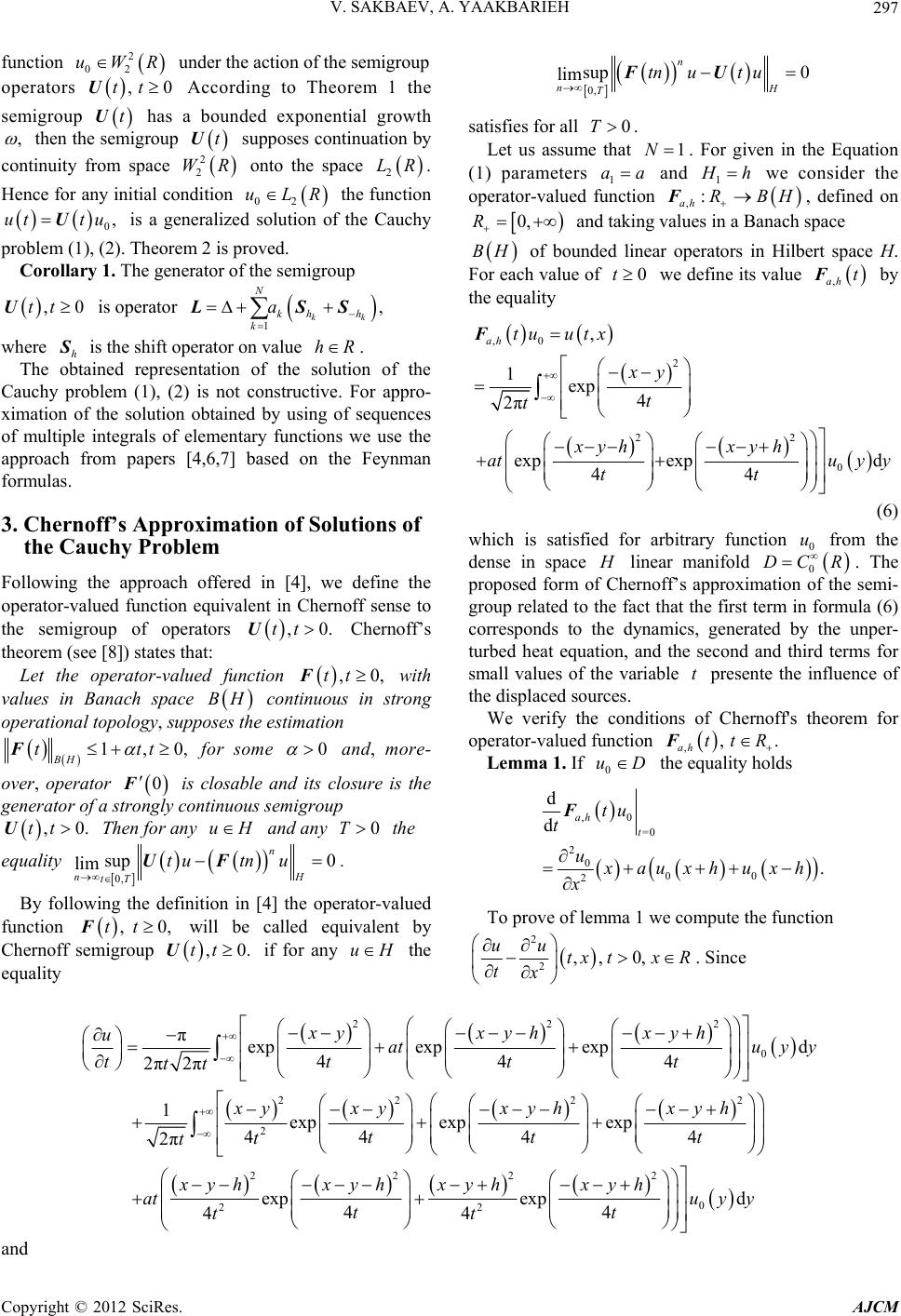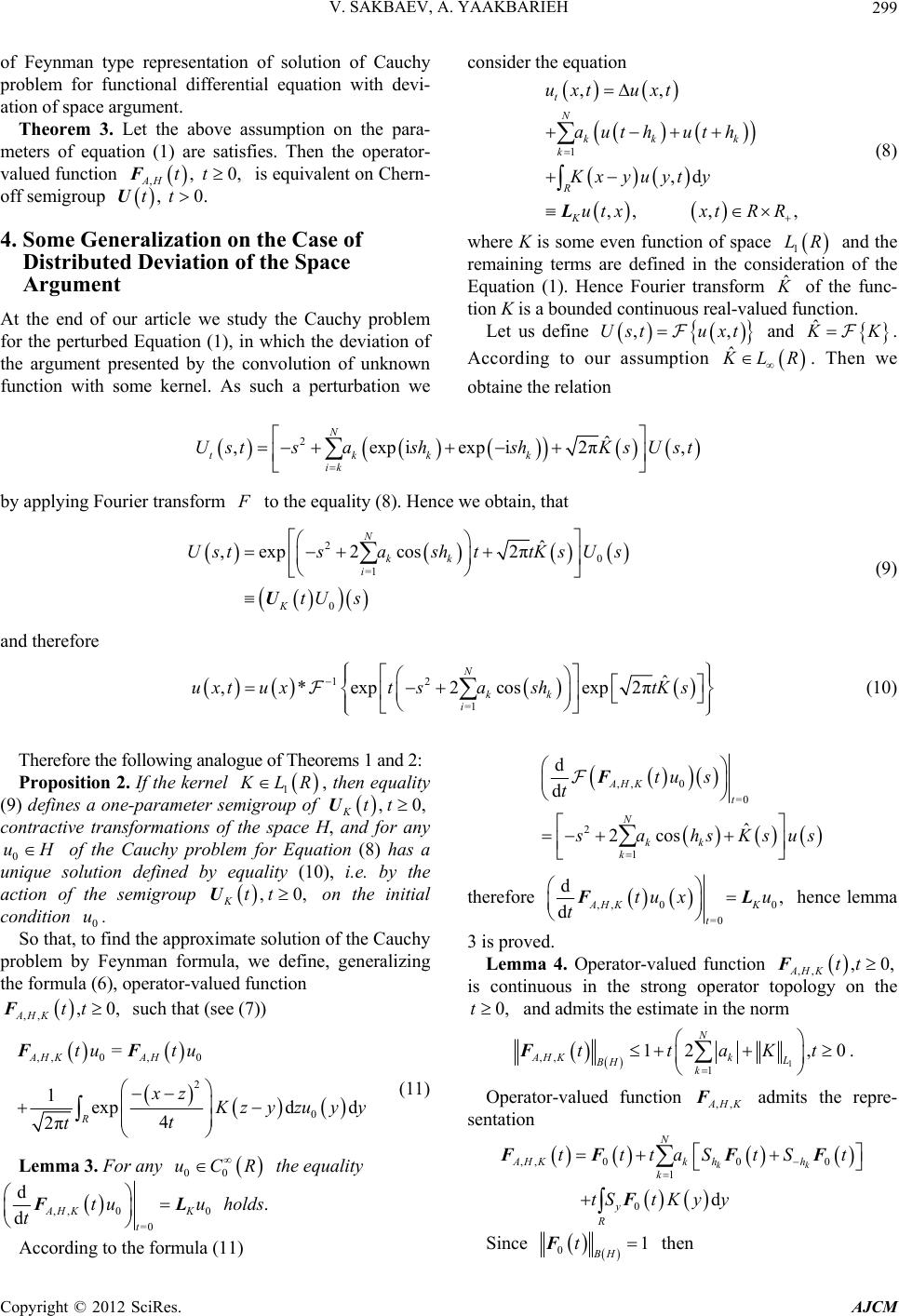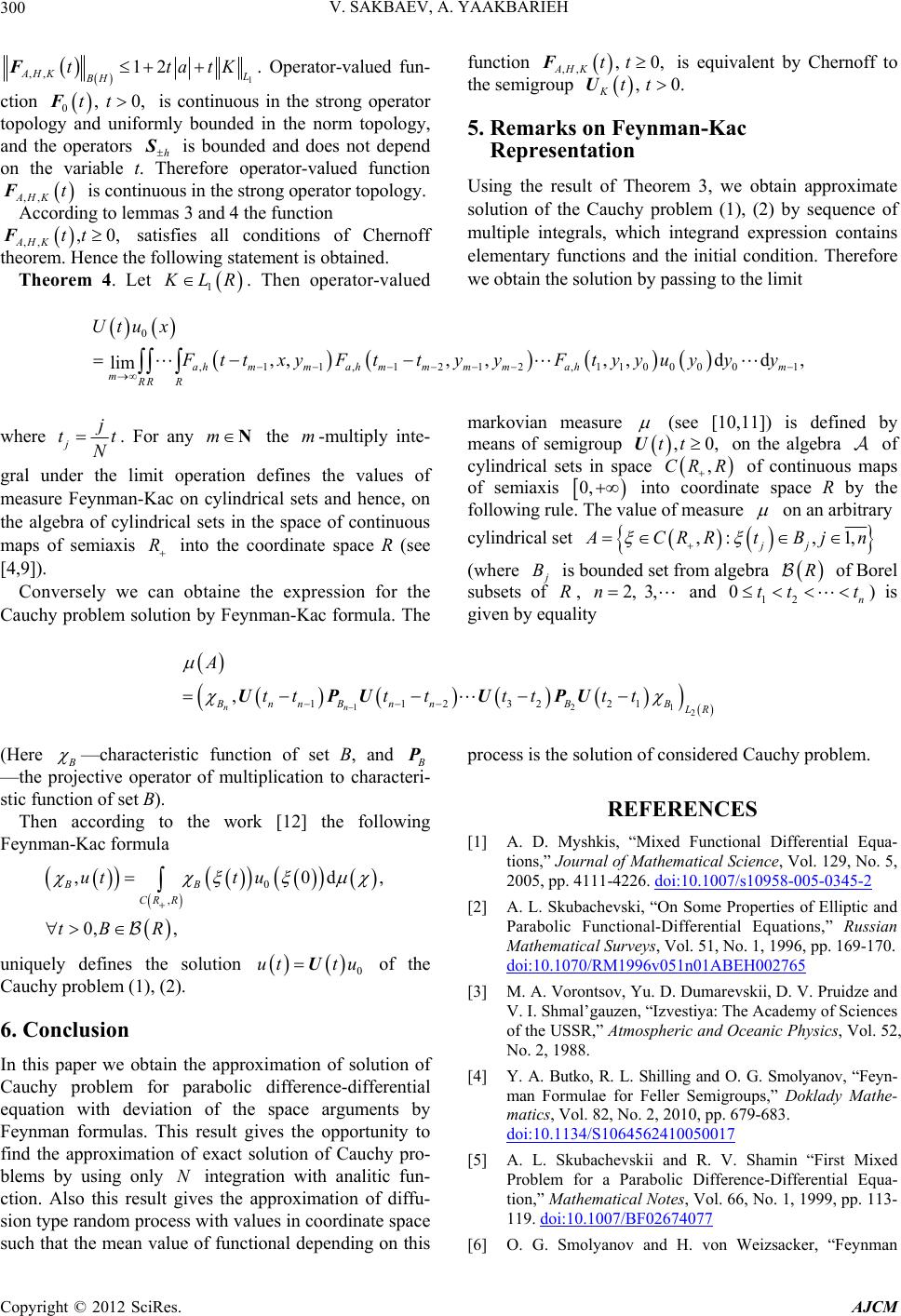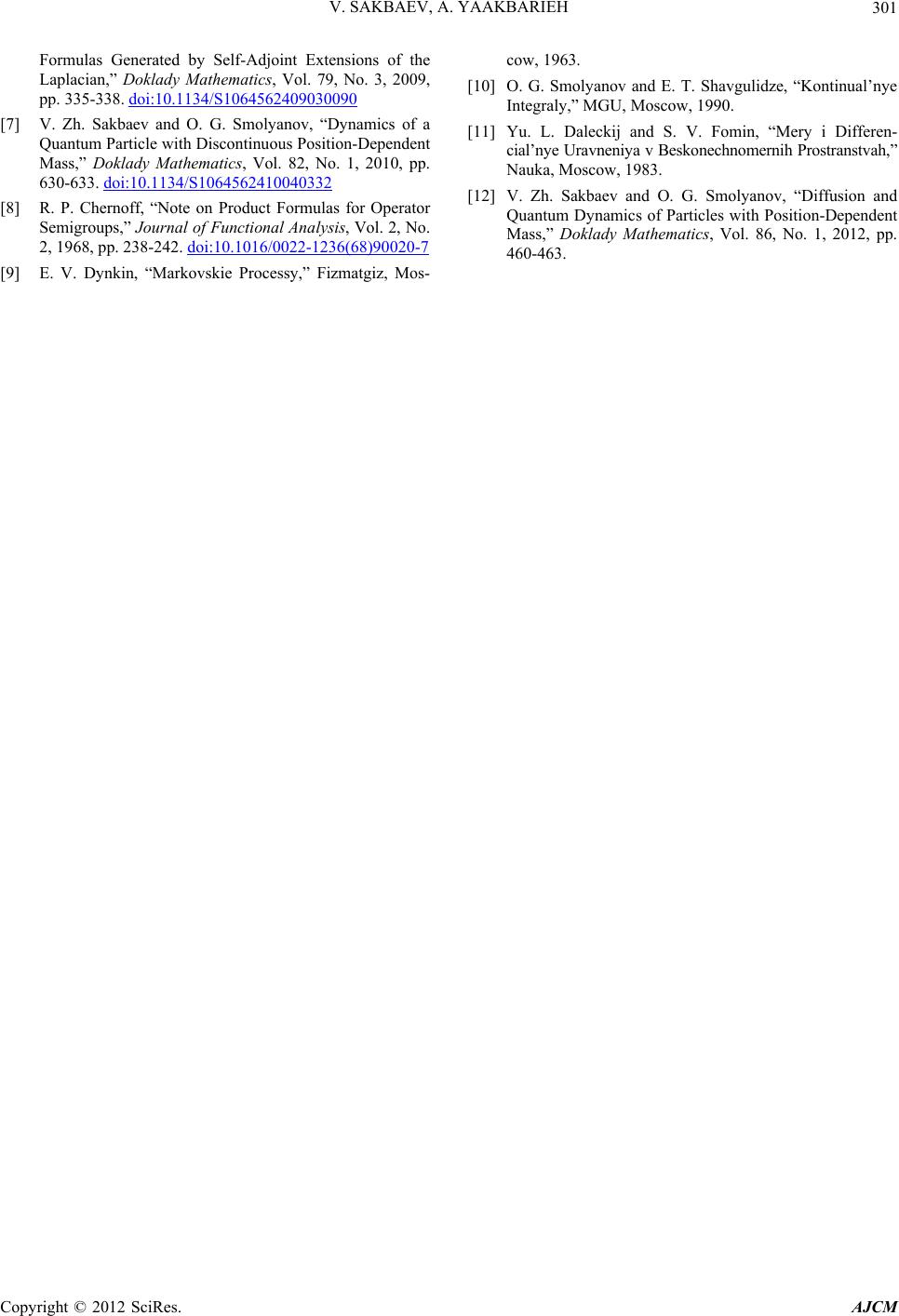 American Journal of Computational Mathematics, 2012, 2, 295-301 http://dx.doi.org/10.4236/ajcm.2012.24040 Published Online December 2012 (http://www.SciRP.org/journal/ajcm) Feynman Formulas Representation of Semigroups Generated by Parabolic Difference-Differential Equations V. Sakbaev, A. Yaakbarieh Moscow Institute of Physics and Technology, People’s Friendship University of Russia, Moscow, Russia Email: fumi2003@mail.ru, amirmath20@yahoo.com Received July 10, 2012; revised October 27, 2012; accepted November 1, 2012 ABSTRACT We establish that the Laplas operator with perturbation by symmetrised linear hall of displacement argument operators is the generator of unitary group in the Hilbert space of square integrable functions. The representation of semigroup of Cauchy problem solutions for considered functional differential equation is given by the Feynman formulas. Keywords: Difference-Differential Equations; Semigroup; Feynman Formula; Chernoff Theorem 1. Introduction In this paper we investigate the questions of correct re- solvability of Cauchy problem for modeling parabolic differential-difference the equations of the form =1 ,, ,,,, t N kk k i uxt uxt auxht uxhtxtRR, (1) supplemented with the initial data 0 ,0, .uxux xR 0 (2) Here , for any , u0 is a given function and NN, kk aRh 2 1, ,kN 2 is self-adjoint Laplas operator in the space 2 LR with domain 2 2 WR u . The equations of this form arise at the description of the phenomena of diffusion or heat conductivity with the sources, nonlocally dependent on the state . Physically the state u means the density distribution of the con- centration or the temperature. In particular, the equations of a kind (1) arise at research of problems of manage- ment by the phenomena of a heat transfer in which dy- namics of a state is given by the differential equation u ,,,, t uxtuxtg txu , with management g. We obtain the Equation (1) in case when management g is given by the action on a state function u of a deviation argument operators in a com- position with operators of differentiation and multipli- cation by the function (see [1-3]). In this work we obtain the representation of semigroup solutions of the Cauchy problem for the functional- differential equation through the Feynman formula (see [4]). It means that although the representation of the evolutionary operator of the Cauchy problem (1) can be defined only in terms of the spectral decomposition (in the simplest situation in terms of the Fourier transform of the solution), nevertheless we obtain an approximation of the evolutionary operator by sequence of n-fold com- positions of integrated operators which kernels are ele- mentary functions. In the terms of the monography [1], differential- difference Equation (1) concerns to type mixed diffe- rential-difference equation without a deviation on time. Nonlinear parabolic differential-difference the equations arise in the investigation of nonlinear optical systems with a feedback (see [3]). In work [5] the mixed problem for nonlinear parabolic differential-difference equations had been formulated. Also it was established what pro- perties distinguish the specified problem from the mixed problem for parabolic differential equations. The linear Cauchy problem (1), (2) can be considered as a linea- rization of specified nonlinear mixed problems. Firstly we prove the correctness of Cauchy problem (1), (2) by using of Fourier transformation and obtain the representation of Fourier image of its solution. After that we construct the approximation of solution by Feynman formulas. We extend the obtained result onto the ope- rators with distributed deviation of the space argument. The obtained results gives not only the expression of the decision of Cauchy problem with the help of con- structive algorithms, but also the investigation of pro- babilistic structure of the phenomena reject the argu- ments in the heat equation. The above Feynman formulas define the approximation of a Markov random process, such that the mean value of some functional on this process is the solutions of the Cauchy problem. C opyright © 2012 SciRes. AJCM  V. SAKBAEV, A. YAAKBARIEH 296 2. Correct Resolvability of the Cauchy Problem and Generation of Semigroup Operators Let us determine the solution of the Equation (1), satisfying the initial condition (2). Definition. A strong solution of the Cauchy problem (1), (2) call the function 21 22 0, ,0, ,uCWR CLR which Sa- tisfies the equation (1) and condition (2). Function 2 0, ,uC LR 0k u u R call a weak solution of the Cauchy problem (1), (2), if there is a sequence of initial data such that 1) the sequence converges in space H to the element , 0k N 0 2) for each there is a strong solution of the Cauchy problem with initial condition , ukk u 0k 3) the sequence of functions converges to fun- u k u ctions in space . u 2 0, ,CL Note that both strong and weak solution satisfies the Equation (1) and condition (2) in the sense of the integral identity. Suppose that the existence of solution of Cauchy problem (1), (2) is ob- tained. To find a representation of the solution of the Cauchy problem (1), (2) through the initial condition, we apply the Fourier transform F to the left and right part of Equation (1): ,, 0,,uxt txR =1 ,, ,, t N kk k i F uxtFu xt Fa ux htux ht , k t (3) Let the function be the ,,,0,Usts Rt Fourier transform in the first variable. Then Equation (3) takes the form: ,uxt 2 1 ,, ,expi,exp i t N kk i UstsUst aUs tshUs tsh , and the initial condition (2) transforms into the equation: 00 ,0 ,UsUsFuss R . Then by using of the equations 2 1 ,, exp iexpi, t N kk k i UstsUst ashshUs and the initial condition we obtain that 2 0 1 ,exp2cos N kk i UstUssasht . (4) Thus, established the following statements Proposition 1. If the Cauchy problem (1), (2) has a solution , then the Fourier transform defined by equality (4). u ,Ust Theorem 1. The formula (4) defines a strongly continuous semigroup , 0,Ut t transformation of the space 2 LR. In fact, according to the unitarity of the the Fourier transform in space 2 LR it is sufficient to verify, that the one-parametrical family of operators ,0tt U, of multiplication on the function ,,Ustt ,R is strongly continuous semigroup ope- rators in space 2 LR with norm not greater than one. Semigroup property 12 1 ,, ,UstUstUst t 0t 2 fol- lows from the properties of the exponential function. The strong continuity in point of operator-function , 0tt U follows from the uniform on any interval of real line convergence of function to the unit function ,, ,UsttRs ,R 1, , sR0t 0t at . Then the strong continuity at any point follows from the semigroup property. Moreovet the type of above semi- groupe is equal to the value , sup sR s os, kk where 2 1 i 2c N ssa shsR . Therefore 1 2 N k k a . The theorem 1 is proved. Theorem 2. The Cauchy problem (1), (2) has a unique generalized solution , 0,ut t U which is defined as the action of the semigroup on the initial condition . ,0tt 0 In fact, according to the proposition 1, if the solution of the Cauchy problem (1), (2) exists, then it re- presentable in the form u 0 12 1 , *exp2 cos. N kk i uxtu x sasht (5) Conversely, if function is de- fined by the equality (4) then the function ,,, 0,Ust sRt 1 ,uxtF Ust , satisfy the equality (5), the equa- lity (1) and the condition (2). In fact, if the function 02 Us LR satisfy the condition 2 02 Us LR then the function t,Us (see (4)): belongs to space 1 22 0, ,0, ,CLRCL R; satisfies the inclusion 2 ,0,, 2 UstCL R and the equation 2 1 ,2cos N kk i Ustsbsh Ust t ,. Then, by the unitarity of the Fourier transform, for each initial function there is the function (5) which is a strong solution of the Cauchy problem (1), (2). Hence, the formula (5) defines the image of the 2 02 uWR Copyright © 2012 SciRes. AJCM  V. SAKBAEV, A. YAAKBARIEH Copyright © 2012 SciRes. AJCM 297 0 function under the action of the semigroup 2 02 uWR ,ttU 0, 0 sup lim n nH Ttnut u FU operators According to Theorem 1 the semigroup has a bounded exponential growth tU , then the semigroup supposes continuation by tU 2 WR satisfies for all . 0T Let us assume that 1N . For given in the Equation (1) parameters 1 aa and 1 h :RB we consider the operator-valued function , defined on H , F continuity from space onto the space 2 2 LR . Hence for any initial condition the function 02 uLRah 0,R and taking values in a Banach space 0,ut tuU is a generalized solution of the Cauchy BH of bounded linear operators in Hilbert space H. For each value of we define its value 0t ,ah tF by the equality problem (1), (2). Theorem 2 is proved. Corollary 1. The generator of the semigroup ,0ttU is operator 1 , kk N khh k a LSS ,0 2 22 0 , 1exp 4 2π exp expd 44 ah tu utx xy t t xyh xyh atuy y tt F where h is the shift operator on value . hR The obtained representation of the solution of the Cauchy problem (1), (2) is not constructive. For appro- ximation of the solution obtained by using of sequences of multiple integrals of elementary functions we use the approach from papers [4,6,7] based on the Feynman formulas. (6) 3. Chernoff’s Approximation of Solutions of the Cauchy Problem which is satisfied for arbitrary function from the dense in space 0 u linear manifold R0 DC . The proposed form of Chernoff’s approximation of the semi- group related to the fact that the first term in formula (6) corresponds to the dynamics, generated by the unper- turbed heat equation, and the second and third terms for small values of the variable presente the influence of the displaced sources. t Following the approach offered in [4], we define the operator-valued function equivalent in Chernoff sense to the semigroup of operators Chernoff’s theorem (see [8]) states that: ,0ttU. , Let the operator-valued function with values in Banach space ,0ttF BH continuous in strong operational topology, supposes the estimation We verify the conditions of Chernoff's theorem for operator-valued function ,, . ah ttR F 1,0 BH tt F,t for some 0 and, more- Lemma 1. If 0 uD the equality holds over, operator is closable and its closure is the generat or o f a strongly co ntinuous se migroup 0 F ,0 =0 2 0 00 2 d d . ah t tu t u au xhu xh x F ,0ttU. Then for any uH and any the 0T equality 0, 0 sup lim n nH tT tutn u UF . By following the definition in [4] the operator-valued function will be called equivalent by Chernoff semigroup if for any , 0,ttFU ,0tt To prove of lemma 1 we compute the function 2 2,,0, uu tx txR tx . Since .uH the equality 222 0 2222 2 πexpexp expd 444 2π2π 1exp expexp 44 4 4 2π xyxyh xyh uatu y y tttt tt xy xyxyhxyh tt t t t x at 2222 0 22 expexp d 44 44 yh xyhxyh xyhuyy tt tt and  V. SAKBAEV, A. YAAKBARIEH 298 22 2 2 22 2 2 22 2 0 2 11 exp exp 244 4 2π 1exp exp 24 4 4 1expexp d 24 4 4 xy xyxy u tt t xt t xyh xyhxyh at tt t t xyhxyhxyh uyy tt t t then 22 2 0 2 1 ,exp exp 44 2π xyh xyh uu txaau y y tt xt d t . Consequently ,0 =0 22 2 0 2 0 2 0 00 2 d d ,exp exp lim 44 2π . ah t t tu t xyh xyh ua txu y y tt xt uxauxhuxh x F d Lemma 1 is proved. For arbitrary and for given in Equation (1) NN coefficients ,, 1, kk ahkN we define the operator fun- ction ,, 0, AH ttF DF assuming that for each function its image defined by equality 0 u ,AH tu 0 , 2 2 =1 1exp 4 2π exp exp. 44 AH Nk k k tux xy t t xyh xyh at tt 2 k F (7) Hence, by lemma 1 on linear manifold D the operator , 0 d dAH t t t F coincides with the generator of the semi- group , 0.Ut t Lemma 2. The operator-valued function ,,0 AH ttF, is continuous in the strong operator topology on the semiaxis and supposes an esti- 0t mation on norm , =1 12, 0 N ahk BH k ttat F. Firstly we prove this statement for the case 1N . The operator-valued function is the sum of function ,ah tF 0tF with the integral kernel of the heat equation and the function with the integral ,ah t kernel , 22 1 ,, 2π exp exp 44 ah txy t xyh xyh at tt . And ,0ahh h tatt SSF, where h —shift operators on the value of h . It is well known that the operator-valued function is continuous in the strong operational topology and uniformly bounded 0,ttF0, the norm topology: 01 BH tF0.t The ope- rators h are bounded and have unit normed. Hence, the operator-valued function is continuous in the strong operator topology and satisfy the estimate ,ah t 2 BH at. If N N then ,0 0 1 ,0 kk N AHkh h k ttatt t . FF FSS Therefore the operator-valued function ,AH tF is continuous in the strong operator topology and satisfy the estimate , 1 12 N AH k BH k tt Fa for any . 0t Thus lemma 2 is proved. Lemmas 1 and 2 exibit that the function ,, AH tF satisfies all conditions of Chernoff theorem. Therefore the next theorem is proved as the main result 0t Copyright © 2012 SciRes. AJCM  V. SAKBAEV, A. YAAKBARIEH 299 of Feynman type representation of solution of Cauchy problem for functional differential equation with devi- ation of space argument. Theorem 3. Let the above assumption on the para- meters of equation (1) are satisfies. Then the operator- valued function is equivalent on Chern- off semigroup ,, 0, AH ttF , 0.ttU 4. Some Generalization on the Case of Distributed Deviation of the Space Argument At the end of our article we study the Cauchy problem for the perturbed Equation (1), in which the deviation of the argument presented by the convolution of unknown function with some kernel. As such a perturbation we consider the equation 1 ,, ,d ,, ,, t N kk k k R K uxt uxt auth uth Kx yuyt y utxxtR R L (8) where K is some even function of space and the remaining terms are defined in the consideration of the Equation (1). Hence Fourier transform 1 LR ˆ of the func- tion K is a bounded continuous real-valued function. Let us define ,,Ust uxt and ˆ K . According to our assumption ˆ L R. Then we obtaine the relation 2ˆ ,exp iexpi2π, N tkkk ik UstsashshKsUst by applying Fourier transform to the equality (8). Hence we obtain, that 2 0 =1 0 ˆ ,exp2cos2π N kk i K UstsashttKsUs tU s U (9) and therefore 12 =1 ˆ ,*exp2cosexp2π N kk i uxtuxtsashtKs (10) Therefore the following analogue of Theorems 1 and 2: Proposition 2. If the kernel 1 LR, then equality (9) defines a one-parameter semigroup of ,0 KttU, contractive transformations of the space H, and for any 0 of the Cauchy problem for Equation (8) has a unique solution defined by equality (10), i.e. by the action of the semigroup uH ,0,tt K U on the initial condition . 0 So that, to find the approximate solution of the Cauchy problem by Feynman formula, we define, generalizing the formula (6), operator-valued function u ,, ,0 AHKttF, such that (see (7)) ,,0 ,0 2 0 = 1expd d 4 2π AHK AH R tu tu xz zyzuyy t t FF (11) Lemma 3. For any 00 uCR the equality ,, 00 =0 d dAHK K t tu u t FL holds. According to the formula (11) ,, 0 =0 2 1 d d ˆ 2cos AHK t N kk k tu s t ahsKsu F s therefore ,, 00 =0 d, dAHK K t tu xu t FL hence lemma 3 is proved. Lemma 4. Operator-valued function ,, ,0 AHKttF, is continuous in the strong operator topology on the and admits the estimate in the norm 0,t 1 ,, 1 12 , N AHKk L BH k ttaK 0t F. Operator-valued function admits the repre- sentation ,,AHK F ,, 000 1 0d kk N AHKk hh k y R tttaStSt tStK yy FF FF F Since 01 BH t F then Copyright © 2012 SciRes. AJCM  V. SAKBAEV, A. YAAKBARIEH 300 1 ,, 12 AHK BH ttat FK. Operator-valued fun- ction is continuous in the strong operator topology and uniformly bounded in the norm topology, and the operators h 0, 0,ttF is bounded and does not depend on the variable t. Therefore operator-valued function is continuous in the strong operator topology. t ,,AHK According to lemmas 3 and 4 the function satisfies all conditions of Chernoff theorem. Hence the following statement is obtained. F ,, ,0 AHKttF, Theorem 4. Let 1 LR. Then operator-valued function ,, , 0, AHKttF is equivalent by Chernoff to the semigroup , 0 KttU. 5. Remarks on Feynman-Kac Representation Using the result of Theorem 3, we obtain approximate solution of the Cauchy problem (1), (2) by sequence of multiple integrals, which integrand expression contains elementary functions and the initial condition. Therefore we obtain the solution by passing to the limit 0 ,11,1212,110000 ,,,,, ,dd, lim ahmmah mmmmahm mRR R Utu x Ftt xyFttyyFtyyuyyy 1 where jj t N t. For any m N the -multiply inte- m gral under the limit operation defines the values of measure Feynman-Kac on cylindrical sets and hence, on the algebra of cylindrical sets in the space of continuous maps of semiaxis into the coordinate space R (see [4,9]). R Conversely we can obtaine the expression for the Cauchy problem solution by Feynman-Kac formula. The markovian measure (see [10,11]) is defined by means of semigroup ,0tt ,CRR , U on the algebra of cylindrical sets in space of continuous maps of semiaxis 0, into coordinate space R by the following rule. The value of measure on an arbitrary cylindrical set ,: ,1, jj CR RtB jn (where B is bounded set from algebra Rorel subsets of R, 2, 3,n of B 12 ) is ity and given by 1 0n t tt equal 12 2 1123221 , nn BnnBnnBB R A ttt ttttt UPU UPU (Here —characteristic function of set B, and P —the projective operator of multiplication to characteri- stic function of set B). Then according to the work [12] the following Feynman-Kac formula 0 , , 0, , BB CR R utt u tB R 0d, uniquely defines the solution of the Cauchy problem (1), (2). 0 ut tuU 6. Conclusion In this paper we obtain the approximation of solution of Cauchy problem for parabolic difference-differential equation with deviation of the space arguments by Feynman formulas. This result gives the opportunity to find the approximation of exact solution of Cauchy pro- blems by using only integration with analitic fun- ction. Also this result gives the approximation of diffu- sion type random process with values in coordinate space such that the mean value of functional depending on this process is the solution of considered Cauchy problem. N REFERENCES [1] A. D. Myshkis, “Mixed Functional Differential Equa- tions,” Journal of Mathematical Science, Vol. 129, No. 5, 2005, pp. 4111-4226. doi:10.1007/s10958-005-0345-2 [2] A. L. Skubachevski, “On Some Properties of Elliptic and Parabolic Functional-Differential Equations,” Russian Mathematical Surveys, Vol. 51, No. 1, 1996, pp. 169-170. doi:10.1070/RM1996v051n01ABEH002765 [3] M. A. Vorontsov, Yu. D. Dumarevskii, D. V. Pruidze and V. I. Shmal’gauzen, “Izvestiya: The Academy of Sciences of the USSR,” Atmospheric and Oceanic Physics, Vol. 52, No. 2, 1988. [4] Y. A. Butko, R. L. Shilling and O. G. Smolyanov, “Feyn- man Formulae for Feller Semigroups,” Doklady Mathe- matics, Vol. 82, No. 2, 2010, pp. 679-683. doi:10.1134/S1064562410050017 [5] A. L. Skubachevskii and R. V. Shamin “First Mixed Problem for a Parabolic Difference-Differential Equa- tion,” Mathematical Notes, Vol. 66, No. 1, 1999, pp. 113- 119. doi:10.1007/BF02674077 [6] O. G. Smolyanov and H. von Weizsacker, “Feynman Copyright © 2012 SciRes. AJCM  V. SAKBAEV, A. YAAKBARIEH 301 Formulas Generated by Self-Adjoint Extensions of the Laplacian,” Doklady Mathematics, Vol. 79, No. 3, 2009, pp. 335-338. doi:10.1134/S1064562409030090 [7] V. Zh. Sakbaev and O. G. Smolyanov, “Dynamics of a Quantum Particle with Discontinuous Position-Dependent Mass,” Doklady Mathematics, Vol. 82, No. 1, 2010, pp. 630-633. doi:10.1134/S1064562410040332 [8] R. P. Chernoff, “Note on Product Formulas for Operator Semigroups,” Journal of Functional Analysis, Vol. 2, No. 2, 1968, pp. 238-242. doi:10.1016/0022-1236(68)90020-7 [9] E. V. Dynkin, “Markovskie Processy,” Fizmatgiz, Mos- cow, 1963. [10] O. G. Smolyanov and E. T. Shavgulidze, “Kontinual’nye Integraly,” MGU, Moscow, 1990. [11] Yu. L. Daleckij and S. V. Fomin, “Mery i Differen- cial’nye Uravneniya v Beskonechnomernih Prostranstvah,” Nauka, Moscow, 1983. [12] V. Zh. Sakbaev and O. G. Smolyanov, “Diffusion and Quantum Dynamics of Particles with Position-Dependent Mass,” Doklady Mathematics, Vol. 86, No. 1, 2012, pp. 460-463. Copyright © 2012 SciRes. AJCM
|